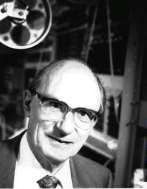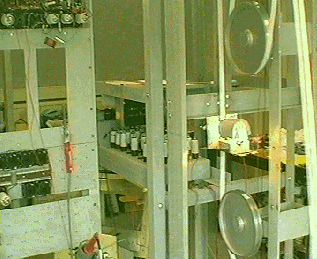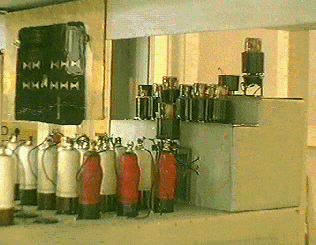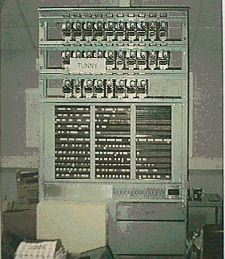The Colossus Rebuild Project
by Tony Sale

Tony Sale's
Codes and Ciphers
The Colossus Rebuild Projectby Tony Sale |  Tony Sale's Codes and Ciphers |
This is Page 3 of 3 pages by Tony Sale about the Lorenz ciphers and the Colossus.
Nobody believed me.
In 1993 I gathered together all the information available. This amounted to the eight 1945 wartime photographs taken of Colossus plus some fragments of circuit diagrams which some engineers had kept quite illegally, as engineers always do!
| The first stage was to produce accurate machine drawings of the frames for Colossus (all the original machine drawings had been burnt in 1960). This involved three months of eyestrain poring over the photographs and using 3D projections to transfer the details to a CAD system, EasyCad running on a 486 PC. |  |
The next problem was the optical paper tape reader system. The details of this are not shown in any of the photographs. However I managed to locate Dr Arnold Lynch who designed the reader system in 1942.

| Although well into his eighties Dr Lynch came to my house and using my CAD system we re-engineered the reader system to his original specifications. |
| Then I
built it and here it is: |

|
 | It uses original Colossus hard vacuum photocells (shown here on the left) and a mask on to which the image of the tape is projected by a Colossus lens. |
I found that sufficient wartime valves were still available, as were various pieces of Post Office equipment used in the original construction.
 |
All the racks are now in place. |
| Here are some of the decade counters. |  |
 | We are also rebuilding the Tunny machine. |
In July 1994 His Royal Highness the Duke of Kent opened the Museums in
Bletchley Park and inaugurated the Colossus Rebuild Project. At that point I
had not managed to obtain any sponsorship for the project but in 1993 my wife
Margaret and I had decided to put our own money into it to get it started. We both
felt that if the effort was not made immediately there would be nobody still
alive to help us with memories of Colossus. Over the next few years various
private sponsors came to our aid and some current and ex-Post Office and
radio engineers formed the team that helped me in the Rebuild.
| ||||||||
At 5,000 cps the interval between sprocket holes is 200 microsecs. In this time Colossus will do up to 100 Boolean calculations simultaneously on each of the five tape channels and across a five character matrix. The gate delay time is 1.2 microsecs which is quite remarkable for very ordinary valves. It demonstrates the design skills of Tommy Flowers and Allen Coombs who re-engineered most of the Mark 2 Colossus.
Colossus is so fast and parallel that a modern PC programmed to do the same code-breaking task takes as long as Colossus to achieve a result!
Finally...The rebuild, which is still ongoing towards a MK 2 Colossus can now be seen in the Museums at Bletchley ParkIt is marvellous tribute to Tommy Flowers, Allen Coombs and all the engineers at Dollis Hill and a great tribute to Bill Tutte, Max Newman, Ralph Tester and all the code breakers involved at Bletchley Park... ...not forgetting all the WRNS who operated and supported Colossus and the interceptors at Knockholt without whom there would have been no messages to break. Lastly I would like to thank my wife Margaret for agreeing to the use of our own money to start up the project and for her continuing support and encouragement. |
The financial sponsors:A E & M D SaleMr Frank Morrell The Mrs L D Rope Third Charitable Settlement Mr Keith Thrower OBE Quantel Ltd |
Contributions by special low prices:Charles Head (Blacksmiths) Billington Exports Ltd Claude Lyons Ltd RSCOATINGS
|
Thanks also to:The Bletchley Park Trust which has allowed free use of the room in H Block where Colossus has been rebuilt.The many hundreds of individuals who have searched their garages and lofts and sent valves for Colossus. | |
The Colossus TeamThe regulars:Cliff Horrocks, David Stanley, Paul Bruton (deceased), John Lloyd, Bob Alexander
Every other weekend:John Pether, Don Skeggs, Adrian Cole, Ron Clayton
Intermittently:Don Grieg (deceased), Philip Hopkins, Richard Watson, Derek Turton, Mark Hyman
By parcel post to Wales:Gil Hayward, the original designer of Mark 2 Tunny who turned some 600 pattern plugs and modified over 1,000 octal valve bases. |
|
Lorenz cipher index page Join the Tour of Bletchley Park to see the Colossus area
You can now see more of the Colossus Reconstruction. Continue to Walk Around Colossus. You can also use an interactive Virtual Colossus. These pages may not be suitable for use with a Macintosh and there may be other browser-dependent features which are not yet optimised. Tony Sale will welcome your comments. You should also see the original 1945 document, The Newmanry History, which was released from secrecy in 2000. It details the methods by which the Lorenz cipher was broken. Tony Sale has now made available HTML and PDF editions of this crucial document. |
| For information about when Bletchley Park and its Museums are open to visitors you must go to the Bletchley Park Trust which is responsible for it. This website has no connection with the Bletchley Park Trust. |
This page was originally created by the late Tony Sale the original curator of the Bletchley Park Museum. Funding for the ongoing maintenance of this section of the site is kindly being provided by Fisher Scoggins Waters Health and Safety Lawyers.
|